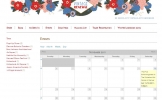Your business card just might be the most valuable marketing material you have. Yet, as busy business owners, it is usually the last thing we think of when planning out branding and promotional materials.
But, think about it: what else can you hand people, send customers and leave with shop owners to make your business memorable? Your business card is your first impression, and a standout business card can make a lasting statement.
The first critical piece in the perfect business card puzzle is deciding what information to include. Your business name is a must, along with a mode of contact and at least one social media site. Here is a handy list of information to consider when drafting the information side of your business card.
-
 Business name
Business name - Your name and position (owner, designer, maker).
- Email address
- Business telephone
- Address (If you have a retail location, this is a must).
- Website
- Blog
- Social media sites: Facebook, Twitter, Instagram, Pinterest, Tumblr
Including all of the above information on your business card might be a bit much in terms of design aesthetic. It really depends on the branding and overall look of your business. (Click here for more ideas for ways to brand your business.)
If it all feels a bit too busy for your taste, one way you can cut down on all the text is to decide upon a central hub where all of your information can be found. Your website is an ideal place to choose, and with a thorough About Me and Contact page, customers should be able to find multiple ways to connect with you and your business.

How To Build an Artist Website
Sign up for our newsletter and get the book How to Build an Artist Website for free!
If you own multiple businesses, each with its own website and brand, another useful tool is to create an about.me page. About.me is a free service where you can create a digital business card of sorts. I use about.me on my blogging business card to connect with contacts that might like to get in touch about my design, consulting, and blog. About.me gives businesses one place to list all social media sites, education, website, and important links in one easy to create and well designed place. What is important here is to decide on how you would like to drive contacts back to your store and site.
Once you decide on content, next up is the fun part: design. As you can see from the photograph, anything goes! It is best when thinking about design to really reflect on the mission and purpose of your business. For example, it would make great sense for a tailor or seamstress to have stitching on her card. The design should support a central theme and hold up against your branding.
If you are selling a product like jewelry or clothing, using product photos on the back of your business card is a great way to remind customers about your designs. Attaching little takeaways, like charms, magnets, or tags, is always memorable. No card size or shape is off limits these days, especially for creative and design businesses. Envelopes, washi tape, and stamps are fun and standout extras that can help make your message memorable.
If you are overwhelmed by design decisions and feel unable to get the ball rolling on your own, hiring a graphic designer to work on your business card might be the right decision. While there is a cost for design and printing, your business card is a critical piece of advertising and worth the expense. Business card sites like moo.com can be helpful in finding a business card style that you like and give you a starting point to work from with a designer or on your own.
(Want to DIY your business cards by hand? Check out this tutorial for tips on making fun handmade beveled cards!)
Share your ideas below. What's memorable about your business card?




